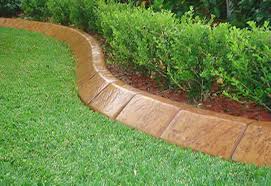Garden edging helps enclose your garden so that you can more effectively use your garden space. Edging is very effective in providing visual continuity and separates various areas of your garden from one another. The choice of materials for garden edging can be challenging, and one of the most important elements of good garden edging is the simplicity of its installation. Simple garden edging enables you to build the edging to fit your garden rather than making assumptions about how it should be constructed.
Trenches are the most common garden edging tools. However, there are other options available to make your work go further and give a better finish. Cutting a narrow, 4-inch deep trench along your garden bed edge with one sloping edge across the bed will provide excellent garden edging. Snap the edges together, drop the garden edging to the trench, and then lay it across the flat edge with a masonry sand blade.
If your garden bed is not straight, plant a border at each side using landscape fabric or an appropriate plant bed border selection. Border material will also prevent edging problems as the garden bed’s soil level will be higher than the border surface. Plant a border on the bottom of the bed, starting in the middle and tacking to the ends. Mulch will insulate the soil and will also help keep weed growth to the minimum.
What are the popular edging materials?
Gravel, rock, and brick are popular garden edging materials. Gravel is ideal for keeping the appearance of grass intact and is relatively easy to install. One disadvantage of using gravel is that it does not hold water well and will wash out quickly when it rains. Rock is a good garden edging material, but because it takes time to set, it can be problematic to lay in an area that is prone to be flooded. However, when the rock is properly set, it creates a natural-looking border and is a strong enough border to support heavier plant roots.
A very nice garden edging idea is to plant sturdy climbers such as wire, gravel, and bricks. These items will not wash out easily, and they provide a firm support edge that will last through the test of time. They are also available in various colours and styles and will coordinate well with any yard. The problem with this type of garden edging is that it may not hold long and will eventually need to be replaced. A better choice is to make use of metal landscape edging.
Metal landscape edging comes in various colours and styles, including classic rectangular, rounded, and angular cuts. Metal can also be shaped to mimic natural materials like stone, bricks, pavers, and river rocks. This is a popular choice when creating a design, but it can also be expensive. Fortunately, a do-it-yourself landscape border project is possible, and here’s how to make use of your backyard’s excess space to create a pleasing border without blowing your budget.
One way to create a natural yard’s appearance is to line a garden bed with long narrow stones. These large stones can serve as decorative accents and add interest to your garden bed. Because these garden edging looks like natural materials, they will withstand the test of time and don’t need to be replaced as often as other types of garden edging. Plus, they’re beautiful!


